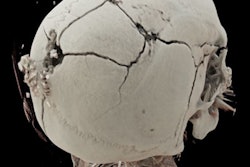CHICAGO - In a head-to-head comparison with conventional autopsy, CT imaging autopsy was as effective in determining cause of death in accidental blunt trauma cases, suggesting that the surgical procedure may be avoided in these incidents.
"CT is a sensitive imaging tool for detecting injuries and cause of death in victims of blunt trauma," said Dr. Barry Daly, a professor of radiology at the University of Maryland in Baltimore. "When there are major injuries, such as those resulting from a motor vehicle accident, CT may provide enough information to enable a conventional autopsy to be avoided altogether."
Imaging technology has long been used in forensic medicine, but the movement to replace conventional autopsy gained momentum in the last decade, Daly said in a presentation at the RSNA 2007 meeting.
The study, conducted by the University of Maryland School of Medicine and the office of Dr. David Fowler, chief medical examiner for the state of Maryland, included 20 trauma victims, of whom 14 were blunt trauma victims and six were victims of penetrating wounds caused by a knife or ballistic weapon.
Whole-body multidetector-row CT (MDCT) was performed in each case to determine cause of death, with the scans interpreted by two radiologists. The results were compared with those from conventional autopsies performed by state forensic medical examiners.
CT autopsy identified cause of death in all 14 cases of blunt trauma, according to Daly. However, in penetrating wound cases, CT autopsy pinpointed cause of death in five of the six cases. CT was unable to determine cause of death in the one case due to laceration of the aorta.
"Autopsy is mandatory in deaths involving gunshot wounds, but CT can serve as a powerful adjunct to the conventional exam," Daly said, especially in cases likely to end up in the courtroom.
Daly noted that the study was limited in numbers and was biased in favor of cases in which CT autopsy was assumed to be effective. The series was also limited as to when the university CT system was available for use.
"CT may become a triage tool in the medical examiner's office to decide who really needs autopsy," he said, "but much more research is needed to determine its true role."
CT autopsy may be helpful in traumatic injury deaths in cases in which states require autopsies but the family is opposed to the surgical procedure on a loved one's body, Daly added.
CT autopsy could relieve considerable time pressures from the medical examiner as well. A traditional autopsy can take several hours to perform, while a CT autopsy can be completed in less than an hour, Daly said. He also suggested that CT autopsies could help pathologists perform limited autopsies by pinpointing the likely cause of death.
By Edward Susman
AuntMinnie.com contributing writer
November 28, 2007
Related Reading
Multidetector CT complements autopsy after death by drowning, May 30, 2007
Part II: Virtual autopsy promises better data on U.S. military casualties, August 6, 2006
Part I: Radiologists prepare for growing CT role in virtual autopsy, May 22, 2006
Expanded role envisioned for imaging in autopsies, May 15, 2006
CT can reduce unneeded laparotomy for patients with gunshot wounds, May 21, 2004
Radiologic 'autopsy' is already finding evidence without destroying it, December 4, 2003
Copyright © 2007 AuntMinnie.com




















